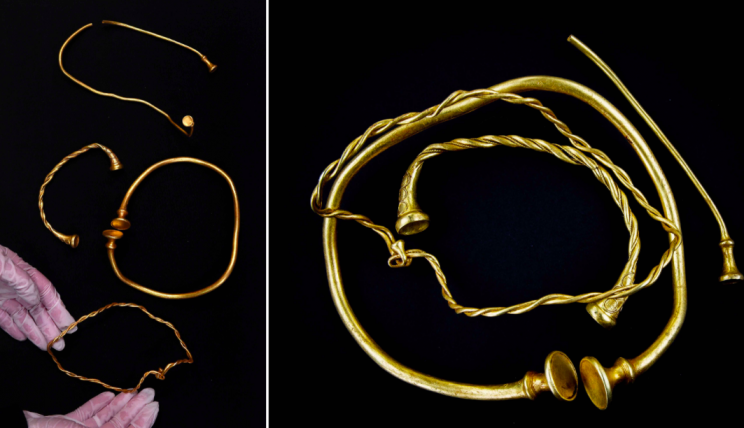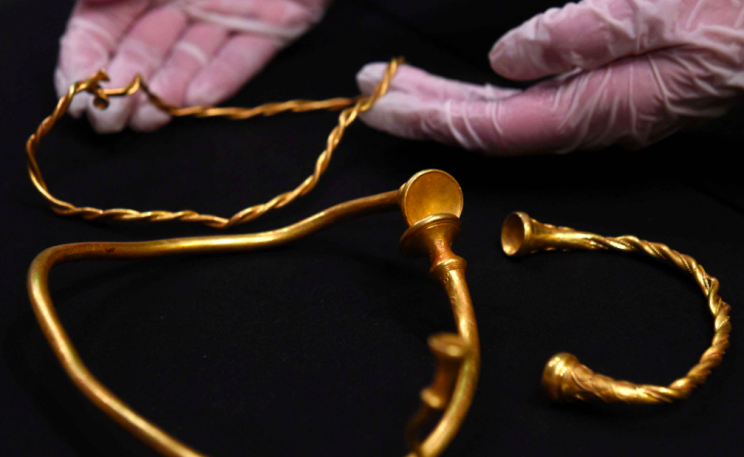‘It’s worth a bob or two!’ Britain's 'oldest' Iron Age gold jewellery found in Staffordshire

A treasure trove of Iron Age gold jewellery is thought to be the oldest ever found in Britain – and likely to be worth a small fortune.
Two amateur treasure hunters uncovered the four near-solid-gold, 18-carat torcs – three necklaces and a bracelet – buried in the middle of cow field on a hillside in Staffordshire last year.
At a formal treasure inquest on Tuesday, senior coroner Ian Smith said it would be “highly desirable” for the unique find to remain in the county.
The torcs’ gold content was at least 80%, with each piece weighing between 230g (8oz) and 31g (1oz).
Mr Smith raised laughter in the public gallery, by joking: “Even as scrap, that’s still worth a bob or two?”

A formal valuation will now take place but a fund-raising campaign is expected to be launched within weeks, aimed at securing the jewellery for permanent public display.
Life-long friends and metal detectorists Mark Hambleton and Joe Kania said they could not believe their eyes when they struck gold in December 2016.
After 60-year-old Mr Kania uncovered one of the bands, they then found three others concealed six inches below ground and a metre apart.
MORE: Pets At Home recall dry cat food after several animals became ‘seriously unwell’
MORE: Heartbreaking moment a baby elephant refused to leave her mum who was killed for her tusks
The jewellery is thought to be up to 2,500 years old, dating back to around 400-250 BC.
One of the torcs was broken, probably by ploughing, and its other half was only discovered when the pair returned to the spot of the first dig last Sunday.
Staffordshire is gaining a reputation as a hiding place for some of the country’s greatest historical treasures, with the latest discovery following 2009’s Anglo-Saxon Staffordshire Hoard find, worth £3.285 million.

This new find near Leek is about 45 miles north of Hammerwich, near Lichfield – the site of the vast 3,900-piece Saxon Hoard, which is perhaps the most famous discovery made by a metal detectorist.
It is not known why the Leekfrith Iron Age Torcs were buried, but it could have been for safekeeping, an offering to the gods, or as an act of remembrance.
The decoration on the sole bracelet has excited experts because it is thought to be some of the earliest Celtic British art.
Mr Hambleton had searched the same field once before, about 20 years ago, but without success.
After scouring the cold ground on the morning of December 11 last year, both men were ready to call it a day when suddenly Mr Kania got a signal.
Pulling out the first torc on his hands and knees, Mr Kania said his initial thought was “bloody hell, I’ve seen this in a treasure-hunting magazine”.
After digging up the rest of the gold, Mr Hambleton admitted he had had a sleepless night with the haul next to his bed.
He handed the gold over to experts at Birmingham Museums the next day, with archaeologists from Staffordshire County Council and Stoke-on-Trent City Council brought in to investigate the finds site.
The men are now planning to split the find 50/50 with landowner Stuart Heath.
A group of independent antiquities experts, the Treasure Valuation Committee, will now estimate what the haul is worth while they will be displayed at the Potteries Museum and Art Gallery in Stoke for the next three weeks.
What is treasure?
All gold and silver objects that are more than 300 years old, and prehistoric base metals (including copper, bronze and lead) are defined as treasure under the Treasure Act 1996, which covers England, Wales and Northern Ireland. People are obliged to report treasure finds in England and Wales but do not have to record archaeological non-treasure items. In Scotland all items – both treasure and non-treasure – must be reported by law.
What happens after something is declared to be treasure?
Depending on how rare or interesting the treasure is considered to be, it can go to a museum. In some cases the finds can be acquired by larger organisations such as the British Museum, but in many cases they will be taken in and displayed by local museums. Around half of the discoveries are returned to the finder, Mr Richardson said. “Some museums may not want them because the objects are in such a poor condition or they already have something similar or the same,” he said. “But we would encourage people to take items to their local museums just in case they are of interest.”
Top pic: PA

 Yahoo News
Yahoo News 


